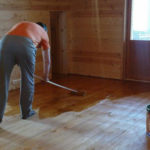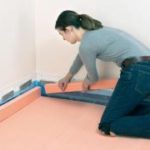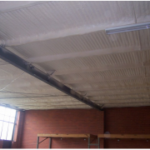Peculiarities of internal and external basement wall insulation. Suitable insulating materials. Steps of installing the insulation.
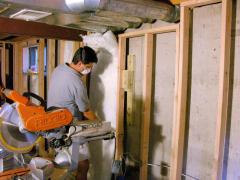 About a fifth of overall heat loss of the house accounts for the basement. The reason for this lies in large non-insulated area below grade level. In addition, earth isn’t an efficient insulator. Along with basement wall insulation, it is often necessary to eliminate penetration of moisture through basement windows and cracks at the sill area. Insulating of the basement can often go with other renovation work like waterproofing or finishing the basement.
About a fifth of overall heat loss of the house accounts for the basement. The reason for this lies in large non-insulated area below grade level. In addition, earth isn’t an efficient insulator. Along with basement wall insulation, it is often necessary to eliminate penetration of moisture through basement windows and cracks at the sill area. Insulating of the basement can often go with other renovation work like waterproofing or finishing the basement.
Basement estimation
When planning work, first check the status of the basement.
- Water leaks must be corrected. It may require excavating, damp- or waterproofing the basement, constructing a drainage system. To correct minor leaks, you can slope the grade to redirect water and plaster the foundation on the inside.
- Dampness can appear in the form of stains or mould, paint peeling efflorescence, blistering and musty smell as well. Slight dampness is corrected on the inside, while a serious problem should be dealt with from the outside.
- Cracks. When there is a presence of an active wall crack, you are to approach to professional aid in regard to structural wall repair.
What kind of insulation for basement walls is better?
Outside insulation is obviously the best option, but more often we have to insulate basement walls from the inside due to practical and economical considerations. Sometimes it is necessary to resort to combination of these two approaches. Consider pros and cons for each approach carefully.
Advantages of interior insulation
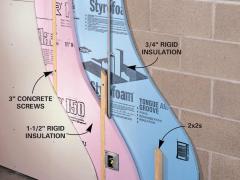 It can be a part of finishing the basement.
It can be a part of finishing the basement.- The work may be carried out gradually at any season and you are able to do the job by yourself.
- You can get rather high insulating values at medium expenses.
- The landscaping or driveway are not affected.
Disadvantages of interior insulation
- A basement with moist walls isn’t suitable for the internal insulation without taking corrective measures.
- The foundation walls can become even colder after adding insulation, which will lead to condensation and occurrence of mould.
- Wiring, plumbing and other fittings obstruct the work and make the insulation covering less effective.
Advantages of exterior insulation
- The outside is solid and easy to insulate.
- Any damp or structural problems can be seen and immediately corrected.
- No house disruption, disturbance by the interior work and no inside area lost.
- No abrupt temperature changes that can affect the footings.
Disadvantages of exterior insulation
- In can be a real challenge to dig a trench around the insulated basement walls by hand.
- You will need to store somewhere the wrenched ground.
- Possibility of carrying out excavation is limited by time of the year as well as by high water table.
- The work can be obstructed by non-removable steps, shrubbery, paved carports, fences, trees etc.
- Obtaining high insulation levels can be quite expensive.
Technology of the outside insulation of the basement
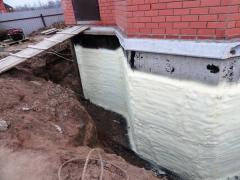 Insulating the basement on the outside consists of the following stages:
Insulating the basement on the outside consists of the following stages:
- Dig a trench. It should be big enough to work.
Sometimes it can be reasonable to mount insulation to 24 inches below grade, i.e. when the drainage system and foundation walls are in proper condition.
- Get the surface prepared
Clean the outer surface with a scraper or a wire brush. Correct any big holes and cracks, and then seal penetrations. Allow the surface to dry.
- Apply the insulation
There are 3 types of insulation for basement walls: rigid boards of mineral wool, dense polystyrene and polyurethane boards.
We suggest using two coats of insulation with overlapped joints. The flashing and corrosion-resistant washers and fasteners are used to hold the insulation in place on the top. The below-grade part of the insulation is held in place by means of the backfill; when installing, some fasteners might be required to keep it in place though.
 Apply the waterproofing starting from the grade level and going down. Then seal all gaps and overlaps.
Apply the waterproofing starting from the grade level and going down. Then seal all gaps and overlaps.
- Apply the flashing. It is necessary to fix the insulation in place and provide neat junctions. You can use either wooden or brick flashing.
- Apply covering for the exposed insulation. It can be expanded metal lath, polymer-modified pargings or pressure-treated plywood.
- Refill the excavation.
How to insulate basement walls inside
Using rigid board insulation works best in case the basement walls are vertical and even as the boards are fairly rigid. Rigid moisture resistant insulation sheets are secured to the concrete by fastening to mechanically attached rails and then protected by means of attaching the gypsum drywall to the fastening rails. In the end, seal the junctions near the joists. Install the ? in gypsum board to protect the wall.
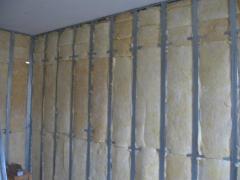 If you’re not sure what type of insulation is most suitable for your basement, you can resort to a combined method which lies in installing a frame wall in 2 inches distance from the basement wall and spraying polyurethane foam against the wall.
If you’re not sure what type of insulation is most suitable for your basement, you can resort to a combined method which lies in installing a frame wall in 2 inches distance from the basement wall and spraying polyurethane foam against the wall.
First, erect the wooden frame wall, without omitting corner studs. Put in one or two layers of batt insulation. After the foam has been installed, the frame is wired and plumbed, and then covered with insulation. Here you shouldn’t apply polyethylene vapor barrier.
Recommend:
How to install roof flashing against a wall
